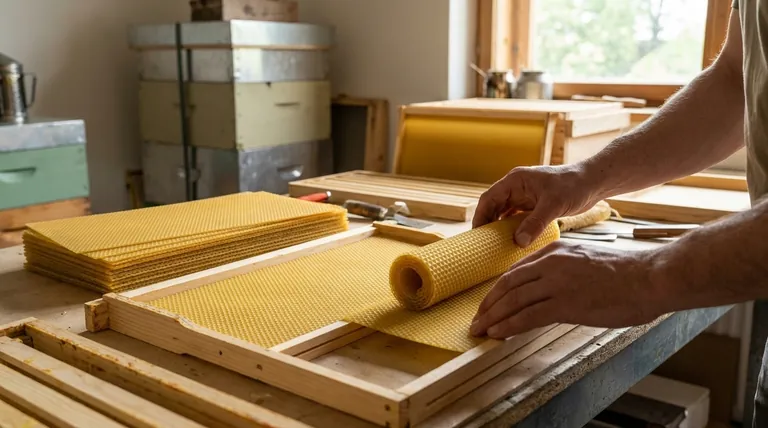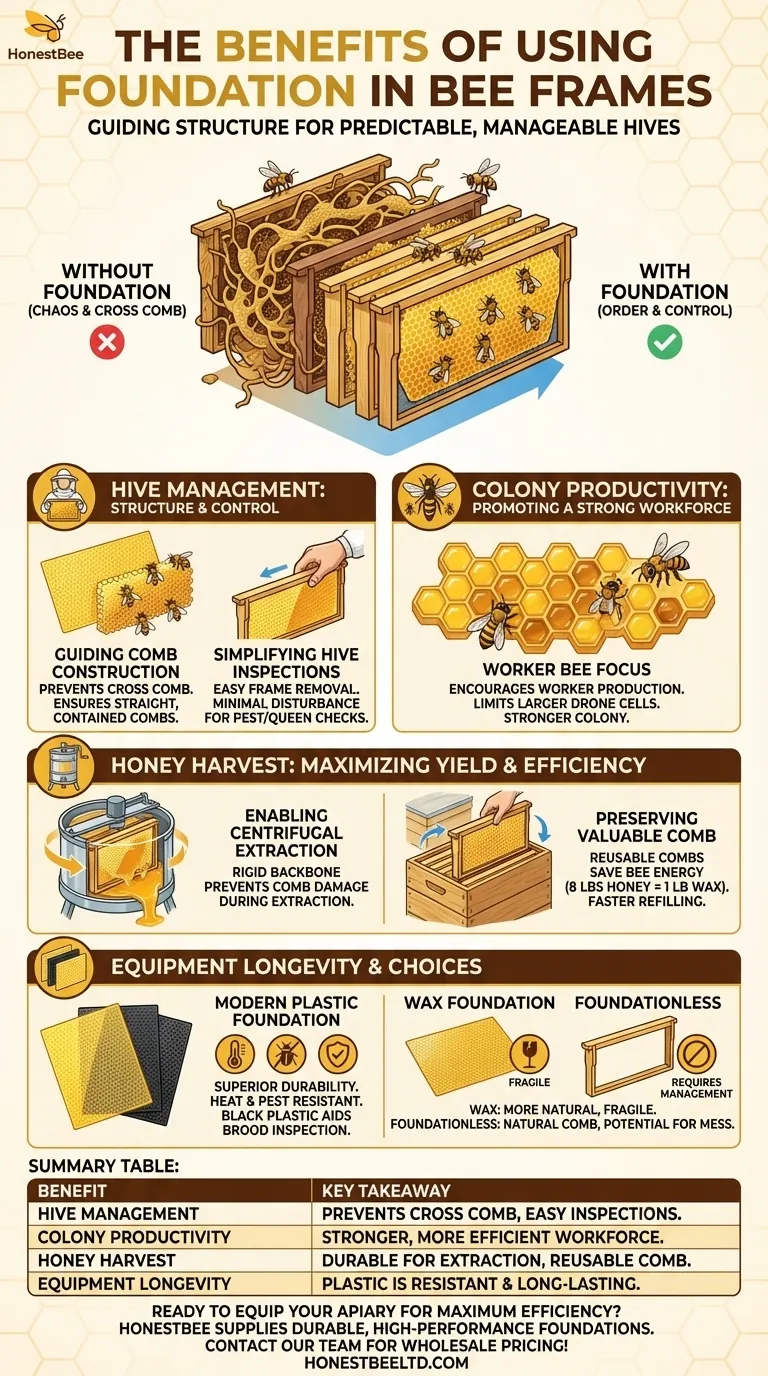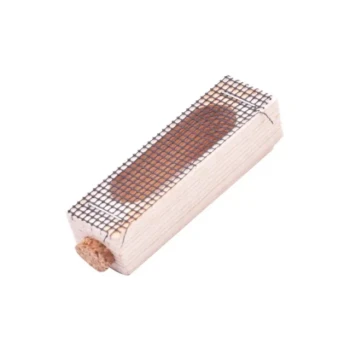In beekeeping, using foundation is the primary method for imposing a predictable and manageable structure on the hive. It provides a template that guides bees to build straight, even combs within the frames, which simplifies hive inspections, maximizes honey harvesting efficiency, and helps promote a more productive colony.
The core purpose of foundation is control. By providing a pre-defined structure, you transform the hive from a wild, interconnected nest into an orderly system where frames can be easily removed, inspected, and managed without causing chaos or harm.

The Foundation of Hive Management: Structure and Control
Using foundation is about creating a predictable environment inside the hive. This predictability is the key to efficient and low-stress beekeeping for both the keeper and the bees.
Guiding Comb Construction
Foundation is a sheet of plastic or pressed beeswax with a hexagonal pattern embossed on its surface. This pattern serves as a guide, encouraging bees to build their comb straight and contained entirely within the frame.
This prevents the creation of cross comb, where bees build comb connecting adjacent frames. Cross comb effectively glues the hive together, making frame removal impossible without destroying the comb, killing bees, and potentially harming the queen.
Simplifying Hive Inspections
With straight, uniform combs, frames slide out easily during an inspection. This allows you to check the queen's laying pattern, monitor for pests and diseases, and assess the colony's resources with minimal disturbance to the bees.
Promoting a Productive Workforce
The hexagonal cells on standard foundation are sized specifically for worker bees. By providing this template, you encourage the queen to lay a higher proportion of worker eggs.
This focus on workers, who perform all the labor in the hive, leads to a stronger, more productive colony and naturally limits the creation of larger drone cells, which house male bees that do not contribute to foraging.
Maximizing Honey Harvest and Equipment Longevity
For any beekeeper interested in harvesting honey, foundation offers significant advantages in both efficiency and durability, especially when using modern equipment.
Enabling Centrifugal Extraction
Honey extractors use centrifugal force to sling honey out of the comb. This process puts immense stress on the comb. Foundation provides a rigid backbone that prevents the delicate wax comb from blowing apart during extraction.
Preserving Valuable Comb
Because the comb remains intact after extraction, it can be returned to the hive for reuse. Bees expend a tremendous amount of energy to produce wax—it's estimated they consume about eight pounds of honey to create one pound of wax.
Reusing comb saves the bees this energy, allowing them to immediately begin refilling the cells with new honey, dramatically increasing the hive's potential honey yield.
The Durability of Plastic Foundation
While traditional foundation is made of beeswax, modern plastic foundation offers superior durability. It does not melt or sag in high heat, is less prone to damage from pests like wax moths, and is nearly indestructible during honey extraction.
For easier inspection of brood, black plastic foundation provides excellent contrast, making it much easier to spot the tiny white eggs and young larvae.
Understanding the Trade-offs and Alternatives
While foundation is the standard for most beekeepers, it's essential to understand it is a choice with specific trade-offs.
Plastic vs. Wax Foundation
The primary choice is between plastic and wax. Plastic is durable, long-lasting, and simple to install. Beeswax foundation is more fragile and requires more careful handling but is often seen as a more "natural" option that bees may accept more readily. Most new plastic foundation comes with a light coating of beeswax to encourage acceptance.
The Foundationless Approach
Some beekeepers opt for foundationless frames, which contain only a guide strip or starter wire. This allows bees to build their comb with their own cell sizing and spacing.
This method is popular for producing natural comb honey or among beekeepers who prioritize a more "hands-off" philosophy. However, it requires more vigilant management to prevent the bees from creating a mess of unmanageable cross comb, especially for beginners.
Making the Right Choice for Your Goal
Your decision to use foundation, and which type, should align directly with your beekeeping objectives.
- If your primary focus is maximum honey production and efficiency: Plastic foundation is the superior choice for its strength during extraction and long-term reusability.
- If your primary focus is monitoring queen health and brood development: Black plastic foundation offers the best visual contrast for spotting eggs and assessing the brood pattern.
- If your primary focus is a more "natural" approach or producing cut-comb honey: Consider using wax foundation or experimenting with foundationless frames in your honey supers.
Ultimately, choosing your foundation is about balancing the bees' natural instincts with your specific goals as a beekeeper.
Summary Table:
| Benefit | Key Takeaway |
|---|---|
| Hive Management | Prevents cross comb, enables easy frame removal for inspections. |
| Colony Productivity | Encourages worker bee production for a stronger, more efficient hive. |
| Honey Harvest | Enables centrifugal extraction and durable, reusable comb. |
| Equipment Longevity | Plastic foundation is heat-resistant and pest-resistant for long-term use. |
Ready to equip your apiary for maximum efficiency and honey yield? HONESTBEE supplies durable, high-performance beekeeping foundations and equipment to commercial apiaries and distributors. Our wholesale-focused operations ensure you get the reliable supplies you need to build a productive and manageable hive. Contact our team today to discuss your foundation needs and wholesale pricing!
Visual Guide

Related Products
- Beeswax Foundation Sheets Beehive Foundation for Wholesale
- Food Grade Plastic bee Foundation for Bee Frames
- Notebook Style Beeswax Foundation Mould Wax Foundation Mold
- HONESTBEE Wired and Assembled Wooden Bee Frames Foundation for a Thriving Hive
- Manual Beeswax Comb Foundation Machine Wax Foundation Mill Embossing Machine
People Also Ask
- What is beeswax foundation used for? A Guide to Efficient Hive Management
- What are wax sheets made of? A Guide to Pure Beeswax Foundation for Healthy Hives
- What are the potential issues if the wax or dipping process is not properly managed? Avoid Cracks, Ripples, and Delamination
- What is 'foundation' in beekeeping, and why is it used? Optimize Hive Management & Honey Production
- What are the characteristics of beeswax foundation? A Natural Choice for Healthy Hives



















